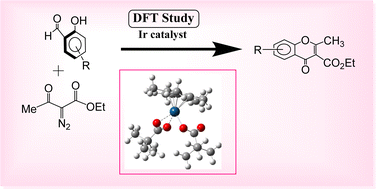Mechanistic insight highlights the key steps and significance of metal in Ir(iii)-catalysed C–H activated chromones generation†
Abstract
A mild C–H activation reaction catalysed by an Ir(III)-complex to generate chromones from salicylaldehydes at room temperature has been studied theoretically to explore the reaction mechanism. The DFT study reveals that the key point of the catalytic cycle is cyclometallation, more precisely it is in the C–H metallation step where the significance of the metal becomes obvious. The favourable pathway includes several steps, namely, coordination of the substrate with the metal catalyst, O–H metallation, C–H metallation, denitrogenation, migration insertion, proton transfer, and demetallation. On removal of one pivalic acid, the metal is activated and the C–H metallation proceeds via oxidative addition followed by reductive elimination. The DFT study clearly indicated that, although there are two possibilities for cyclometallation, it only proceeds via O–H metallation followed by stepwise C–H metallation. The effect of substituents on the mechanism was also been studied. The low energetic span obtained for this catalytic cycle implies that the reaction can proceed at room temperature, and this is consistent with the experimental result.



 Please wait while we load your content...
Please wait while we load your content...